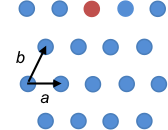In crystallography, it is convenient to explain certain concepts using vectors and matrices. For example, a lattice point in a two-dimensional lattice can be described by the position vector, r, in the form:
where u and v are integers; a and b are primitive translation vectors or basis vectors.

The red lattice point in the above diagram is represented by r = a + 2b. Basis vectors in two dimensions are usually chosen to be the shortest vectors linking two pairs of neighbouring lattice points. They can be selected anywhere in the lattice as long as they originate from the same lattice point. In three dimensions, we have:
